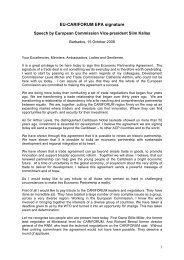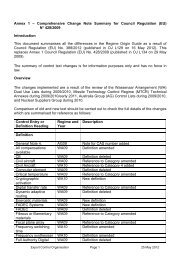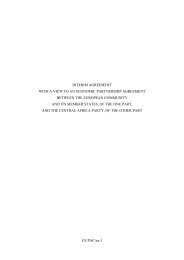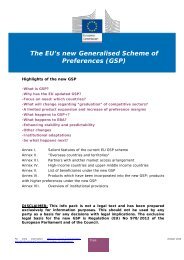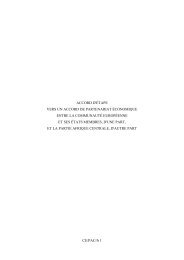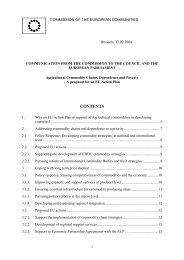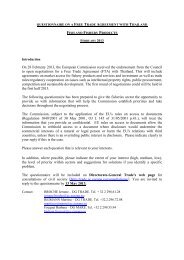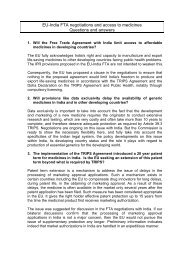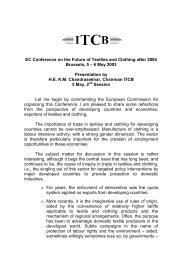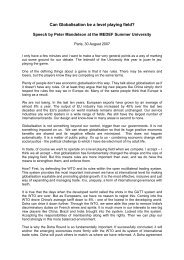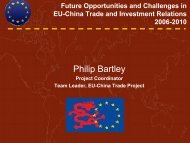Report on the Implementation of the derogation to ... - Trade Websites
Report on the Implementation of the derogation to ... - Trade Websites
Report on the Implementation of the derogation to ... - Trade Websites
Create successful ePaper yourself
Turn your PDF publications into a flip-book with our unique Google optimized e-Paper software.
Final <str<strong>on</strong>g>Report</str<strong>on</strong>g><br />
RoO Derogati<strong>on</strong> under <strong>the</strong> PACP-IEPA<br />
access <strong>to</strong> Ind<strong>on</strong>esian waters, <strong>the</strong> closure <strong>of</strong> <strong>the</strong> HSPs (an important fishing area for <strong>the</strong>se vessels),<br />
and c<strong>on</strong>tinuing low availability <strong>of</strong> fish in Philippines waters. These vessels, which were already<br />
fishing in <strong>the</strong> WCPO but not within PNA waters (and hence, were not <strong>on</strong> <strong>the</strong> FFA RVR), currently<br />
supply little raw material <strong>to</strong> PNG’s existing canneries, with most fish landed in Philippines. However,<br />
<strong>the</strong>y may do so in <strong>the</strong> future utilising global sourcing if PNG’s processing capacity increases, as<br />
planned. Relatively few <strong>of</strong> <strong>the</strong> new or re-flagged/relocated vessels are EU compliant in SPS terms<br />
(see Secti<strong>on</strong> 5.6.1).<br />
As noted, some <strong>of</strong> <strong>the</strong> increase in vessel numbers involves migrati<strong>on</strong> <strong>on</strong><strong>to</strong> <strong>the</strong> FFA RVR, not new<br />
fishing effort in<strong>to</strong> <strong>the</strong> regi<strong>on</strong>; <strong>the</strong>se vessels were already fishing within <strong>the</strong> WCPFC C<strong>on</strong>venti<strong>on</strong> Area<br />
outside <strong>of</strong> FFA members’ waters (e.g. <strong>the</strong> Philippines vessels formerly fishing as domestic vessels and<br />
not <strong>on</strong> <strong>the</strong> register until licensed under bilateral access in PNG since 2007). There is also effort<br />
expansi<strong>on</strong> related <strong>to</strong> building domestic capacity/domesticati<strong>on</strong> (e.g. growing RMI fleet) or<br />
commercial expansi<strong>on</strong> <strong>of</strong> comparatively new entrants <strong>to</strong> <strong>the</strong> fishery (e.g. China), which is unrelated<br />
<strong>to</strong> derogati<strong>on</strong>.<br />
Current raw material flows<br />
Raw material caught by purse seiners operating in <strong>the</strong> WCPO is shipped <strong>to</strong> many countries for<br />
processing, as well as directed in some cases <strong>to</strong> processing facilities based in PICs (i.e. PNG, Solom<strong>on</strong><br />
Islands, Fiji, Marshall Islands) (see Secti<strong>on</strong> 6.7.4). Current raw material flows for WCPO processing<br />
involve <strong>the</strong> following destinati<strong>on</strong>s:<br />
• Thailand for canning/loining 142 (750,000 mt in 2010, or 41% <strong>of</strong> <strong>the</strong> <strong>to</strong>tal purse seine catch),<br />
with Taiwan, <strong>the</strong> US and Korea <strong>the</strong> major suppliers; also Japan, Vanuatu, Marshalls, El<br />
Salvador, China, Ind<strong>on</strong>esia, Solom<strong>on</strong> Islands, PNG and o<strong>the</strong>rs.<br />
• Philippines for canning (220,000 mt, comprising, in approximately equal amounts, fish from<br />
domestic vessel catch (though this is decreasing), catch by Philippines vessels fishing in PNG<br />
(both chartered and bilateral access), and o<strong>the</strong>r fleets, including Japan, Korea and Taiwan.<br />
• Korea for canning (120,000 mt), supplied by own fleet.<br />
• Pago Pago for canning (100,000 mt estimated), supplied by US and Korean fleets.<br />
• Japan for canning, katsuobushi, fresh c<strong>on</strong>sumpti<strong>on</strong> (150,000 mt, mostly supplied by own<br />
fleet).<br />
• Ind<strong>on</strong>esia – large domestic c<strong>on</strong>sumpti<strong>on</strong> (>100,000 mt), canning (90,000 mt).<br />
• Eastern Pacific Ocean, for canning (100,000 mt, mostly Ecuador), mostly supplied by Kiribati,<br />
Spain, Ecuador, El Salvador .<br />
• PNG for processing (~70,000 mt), most fish from domestic vessels, chartered vessels, some<br />
from bilateral access vessels, mostly from within PNG EEZ; large volumes exported as frozen<br />
whole round for canning elsewhere (e.g. Philippines, Thailand).<br />
Potential future changes in fleet pr<strong>of</strong>ile<br />
With <strong>the</strong> shift <strong>to</strong> <strong>the</strong> Vessel Day Scheme in 2007, <strong>the</strong>re are no l<strong>on</strong>ger explicit capacity limits in <strong>the</strong><br />
WCPO purse seine fishery, o<strong>the</strong>r than <strong>the</strong> n<strong>on</strong>-binding 2005 Resoluti<strong>on</strong> <strong>on</strong> Reducti<strong>on</strong> <strong>of</strong><br />
Overcapacity. 143 With <strong>the</strong> advent <strong>of</strong> VDS, <strong>the</strong> number <strong>of</strong> vessels has grown c<strong>on</strong>siderably since 2007,<br />
though not all are new vessels (Table 5.3). N<strong>on</strong>e<strong>the</strong>less, no fur<strong>the</strong>r increases in overall WCPO purse<br />
142 Thai imports are listed by flag ra<strong>the</strong>r than by beneficial ownership.<br />
143 WCPFC Resoluti<strong>on</strong> 2005-02.<br />
Linpico s.a.r.l. Page 88




